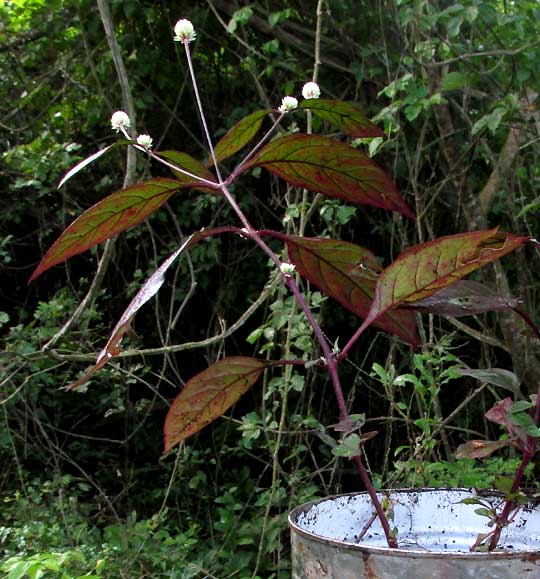Excerpts from Jim Conrad's
Naturalist Newsletter
from the January 3, 2016 Newsletter issued from Hacienda Chichen Resort beside Chichén Itzá Ruins, central Yucatán, MÉXICO
RUBY LEAF
I don't recall seeing three years ago when I was staying at Hacienda Chichen the purple-leafed plant shown below adorning the base of a big Piich tree at the edge of the garden:

That plant is all over the place now, both planted and going wild. In the picture, notice that many of the plants arise inside a long planter, barely visible at the picture's lower, left corner, but many other plants have rooted outside the planter and are doing just as well as those inside it. This is definitely a plant capable of becoming invasive.
Still, it makes such a pretty show that when some turned up at the forest edge, apparently having been dumped there by the gardeners, I salvaged and transplanted them into a tin can, until they could recuperate enough to be planted next to the hut. A closer view of a single plant is shown below:

At first I thought this was an escaped, white- and smaller-flowered form of the Globe Amaranth, which you can compare at www.backyardnature.net/yucatan/globe-am.htm.
However, notice that the spherical heads of Globe Amaranths produce leaves immediately below their heads, while our plants' spherical heads are set atop long, leafless stems, or peduncles. Botanically, that's a big deal, throwing our plants into an entirely different genus. However, with those white, stiff "bracts" forming the spherical heads, with tiny, hard-to-see flowers down among the bracts, they're clearly in the same family as Globe Amaranths, the Amaranth Family, the Amaranthaceae. A close-up of our tin-can plant's head showing not a hint of leaves below the head, appears below:

Finally I remembered that here at the Hacienda back in 2010 I found an Amaranth Family member without leaves below their white heads, growing on the wall of the old church, as shown at www.backyardnature.net/yucatan/joyweed.htm.
That's a member of the genus Alternanthera, species of which often are called joyweeds. The church-wall plants and our tin-can one are so similar that now the question becomes, is our tin-can plant just a purple-leafed form of the church-wall one, or is it a different species of Alternanthera?
It turns out that it's a different species, ALTERNANTHERA BRASILIANA, known by many English names, the most common one seen in print being Brazilian Joyweed. That name is misleading, though, because the species is native from Brazil north through northern South America and Central America, to Mexico and the Caribbean. Among its other names are Metal Weed, Parrotleaf, Joseph's Coat, Calico Plant, Ruby Calico and Ruby Leaf, the latter appealing to me most. That name causes me to wonder if maybe the name joyweed derives from rubies being jewels, and Spanish for jewel being joya.
Ruby Leaf has become an invasive in Florida, so it's found in the US and thus described in the online Flora of North America. In that detailed description there's no mention of its leaves being purplish. However, gardeners favor the species, especially as a hedging plant, so several cultivars with various degrees of purplish leaves have been developed. Maybe ours is an escaped cultivar -- or possibly it's a natural purplish form from which the purplish cultivars have been developed. I don't find green-leafed forms here, though plants growing in deep shade tend to be more green than purple, as do freshly emerging leaves.
Ruby Leaf is busy escaping into the wild in much of the world's tropics. In Australia it's regarded as a weed causing environmental impacts, particularly along waterways in warmer and wetter coastal areas.